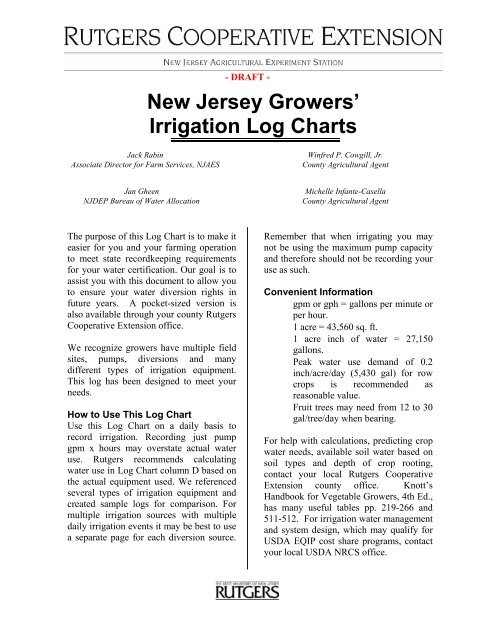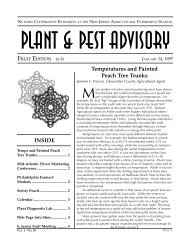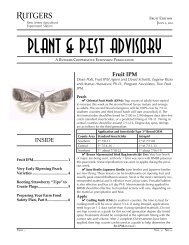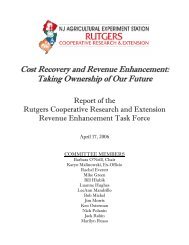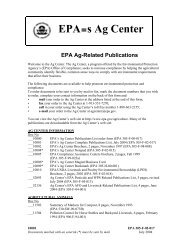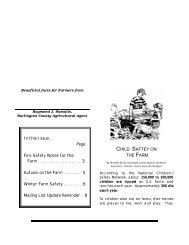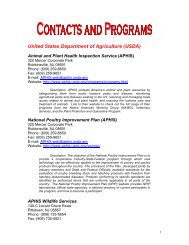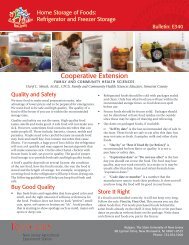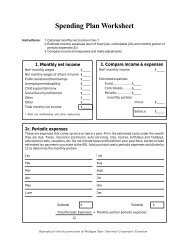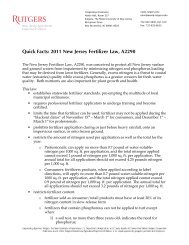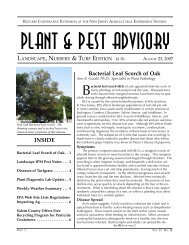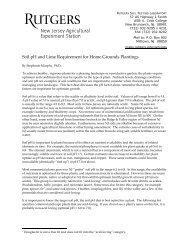Irrigation Log Charts - Rutgers New Jersey Agricultural Experiment ...
Irrigation Log Charts - Rutgers New Jersey Agricultural Experiment ...
Irrigation Log Charts - Rutgers New Jersey Agricultural Experiment ...
You also want an ePaper? Increase the reach of your titles
YUMPU automatically turns print PDFs into web optimized ePapers that Google loves.
Jack Rabin<br />
Associate Director for Farm Services, NJAES<br />
Jan Gheen<br />
NJDEP Bureau of Water Allocation<br />
- DRAFT -<br />
<strong>New</strong> <strong>Jersey</strong> Growers’<br />
<strong>Irrigation</strong> <strong>Log</strong> <strong>Charts</strong><br />
The purpose of this <strong>Log</strong> Chart is to make it<br />
easier for you and your farming operation<br />
to meet state recordkeeping requirements<br />
for your water certification. Our goal is to<br />
assist you with this document to allow you<br />
to ensure your water diversion rights in<br />
future years. A pocket-sized version is<br />
also available through your county <strong>Rutgers</strong><br />
Cooperative Extension office.<br />
We recognize growers have multiple field<br />
sites, pumps, diversions and many<br />
different types of irrigation equipment.<br />
This log has been designed to meet your<br />
needs.<br />
How to Use This <strong>Log</strong> Chart<br />
Use this <strong>Log</strong> Chart on a daily basis to<br />
record irrigation. Recording just pump<br />
gpm x hours may overstate actual water<br />
use. <strong>Rutgers</strong> recommends calculating<br />
water use in <strong>Log</strong> Chart column D based on<br />
the actual equipment used. We referenced<br />
several types of irrigation equipment and<br />
created sample logs for comparison. For<br />
multiple irrigation sources with multiple<br />
daily irrigation events it may be best to use<br />
a separate page for each diversion source.<br />
Winfred P. Cowgill, Jr.<br />
County <strong>Agricultural</strong> Agent<br />
Michelle Infante-Casella<br />
County <strong>Agricultural</strong> Agent<br />
Remember that when irrigating you may<br />
not be using the maximum pump capacity<br />
and therefore should not be recording your<br />
use as such.<br />
Convenient Information<br />
gpm or gph = gallons per minute or<br />
per hour.<br />
1 acre = 43,560 sq. ft.<br />
1 acre inch of water = 27,150<br />
gallons.<br />
Peak water use demand of 0.2<br />
inch/acre/day (5,430 gal) for row<br />
crops is recommended as<br />
reasonable value.<br />
Fruit trees may need from 12 to 30<br />
gal/tree/day when bearing.<br />
For help with calculations, predicting crop<br />
water needs, available soil water based on<br />
soil types and depth of crop rooting,<br />
contact your local <strong>Rutgers</strong> Cooperative<br />
Extension county office. Knott’s<br />
Handbook for Vegetable Growers, 4th Ed.,<br />
has many useful tables pp. 219-266 and<br />
511-512. For irrigation water management<br />
and system design, which may qualify for<br />
USDA EQIP cost share programs, contact<br />
your local USDA NRCS office.
Drip <strong>Irrigation</strong> Management Example<br />
for Vegetables<br />
<strong>Irrigation</strong> wetting to the proper effective<br />
soil rooting depth (varies by crop) is<br />
recommended on or before soils are ½<br />
depleted of their available soil water. For<br />
example, wetting soil to 12 inches for<br />
shallow rooted crops needs from 1/3 inch<br />
of water on coarse sandy loam soils to 3/4<br />
inch on loam soils. This affects how many<br />
hours the system is run. The <strong>Rutgers</strong><br />
Commercial Vegetable Production<br />
Recommendations has tables to simplify<br />
calculations.<br />
Drip emitter rates vary. A typical 0.5<br />
gpm/100 row ft. drip line on 5 ft. row<br />
centers is about 8,500 row ft/acre and uses<br />
42.5 gpm (2,550 gph).<br />
One acre inch of irrigation water is 27,150<br />
gallons. Using the example of 0.5 gpm drip<br />
line above we can calculate the gallons<br />
needed and run time.<br />
27,150 g/acre inch x .33 inch = 8,960<br />
g/acre needed per irrigation to irrigate<br />
sandy soils and 20,363 g/acre (27,150<br />
g/acre inch x .75 inch) to wet loam soils to<br />
12 inch depth.<br />
8,960 g/acre ÷ 2,550 gph emitted = 3.5<br />
minimum hours run time for 1/3 inch<br />
irrigation. More frequent irrigations of less<br />
duration will not wet soil to desired rooting<br />
depth.<br />
To figure out how many emitters you have<br />
per acre, find out the spacing of emitters<br />
on the drip tape and the total row feet you<br />
have per acre. After finding out how many<br />
total row feet per acre, divide that number<br />
by the spacing between emitters. If you<br />
had a 12 inch spacing between emitters<br />
and 8,500 row feet per acre, the calculation<br />
would be 8,500 ÷ 12 =708 emitters per<br />
acre.<br />
During peak summer growth with no<br />
rainfall, the crop soils will need at least 1.4<br />
inches/week (0.2 inch/day) of water. If 3.5<br />
hours delivers .33 inch, then it requires a<br />
minimum of about 15 hours weekly run<br />
time to deliver 1.4 inches. This could be<br />
done with 5 hours on alternate days to<br />
make management more convenient.<br />
Check soils with tensiometers, watermark<br />
sensors or by feel to adjust irrigation run<br />
times as needed. Some growers are also<br />
utilizing evapo-transpiration models to<br />
schedule irrigation.<br />
We do not generally consider infiltration<br />
rates when drip irrigating in southern <strong>New</strong><br />
<strong>Jersey</strong>. However caution should be used to<br />
not overwater (i.e., use excessive run<br />
times) on clay or compacted soils or if<br />
there is risk of Phytophthora blights.<br />
Excessive run times can move the water<br />
and nutrients past the root zone.
A<br />
Date of<br />
Water Use<br />
B<br />
<strong>Irrigation</strong><br />
Source<br />
Name or #<br />
<strong>Irrigation</strong> Use Record Keeping Chart<br />
C<br />
Hours<br />
per<br />
day<br />
D (use one of the following calculations)<br />
1) gph = gpm pumped x 60 min.<br />
2) gph = sprinkler gpm x # sprinklers x 60 min.<br />
3) gph = drip gpm per 100 row feet x # row feet per<br />
acre ÷ 100 x 60 min.<br />
4) gph = drip gpm per acre x 60 min.<br />
5) gph = drip emitter gph x # emitters<br />
E<br />
Daily Total<br />
= Hours x gph (gallons per hour)<br />
= C x D<br />
THIS SHEET MAY BE DUPLICATED TO MAKE ADDITIONAL COPIES FOR YOUR RECORDS
Resources<br />
2002 <strong>Rutgers</strong> Commercial Vegetable Production Recommendations, pgs B20 -22.<br />
Knott’s Handbook for Vegetable Growers, 4th Ed., pp. 219-266 and 511-512.<br />
Websites of Interest<br />
University of Nebraska <strong>Irrigation</strong> Website at<br />
http://www.ianr.unl.edu/pubs/<strong>Irrigation</strong>/index.htm<br />
USDA Water Management Research Unit at http://www.cprl.ars.usda.gov/wmru.htm<br />
USDA Web Links to other <strong>Irrigation</strong> Information at<br />
http://fresno.ars.usda.gov/wmrl/Otherlinks.html<br />
Washington State University Irrigated Agriculture and Extension Center at Prossor,<br />
WA at http://www.prosser.wsu.edu/<br />
© 2002 by <strong>Rutgers</strong> Cooperative Extension, <strong>New</strong> <strong>Jersey</strong> <strong>Agricultural</strong> <strong>Experiment</strong> Station, <strong>Rutgers</strong>, The State University of<br />
<strong>New</strong> <strong>Jersey</strong>. This material may be copied for educational purposes only by not-for-profit accredited educational<br />
institutions.


